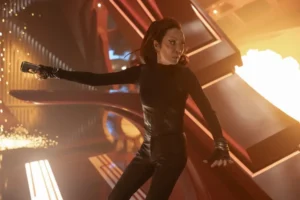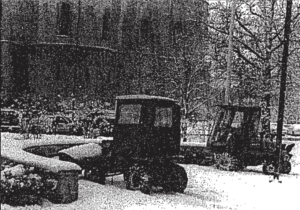The Kennedy Center: Otello

Image courtesy of The Kennedy Center
By Kat Kaderabek
Recently, the Kennedy Center performed a short run of the opera, based on the Shakespearean play, entitled Otello. The show was performed in Italian, and featured the debut opera singer Russell Thomas as the lead. The role of Otello has been deemed the “Mount Everest” of tenor repertory as reported by The Kennedy Center to which Thomas rose to the challenge.
“The show was really incredible,” explained sophomore math major, Garrett Farrell. “I was really astounded by how talented everyone in the performance was, especially during the numbers which required a large ensemble of actors.”
Farrell attended the performance with the University Honors College, run by Dr. Jennifer Paxton of the History Department. Paxton also attended the show and thought it extraordinary, as Otello is her favorite opera by Guiseppe Verdi. Regarding the show, Paxton called the ending scene a “fascinating choice.”
“After Otello stabs himself and collapses next to the body of Desdemona, claiming from her one last kiss, the courtiers withdraw in horror, leaving only Iago on stage with the dead lovers, sitting apart, immobilized,” Paxton said. “It is almost as if he has realized at the end that they share something he cannot be part of and that his effort to destroy them has rung hollow. He has not won after all. At least, that is how I would like to interpret it.”
The final scene of the opera was riveting and powerful in its silence alone. The starkness of the tragedy was clear, and the scene was filled with so much frustration that was aided in the dramatic irony of the entire show. The audience, and every other character aside Otello, knew of Desdemona’s innocence and yet she was murdered on the word of a snake.
The tragedy was best exemplified in the dreary scene on which the opera took place. From the color of the walls to the gray and black costumes, there was very little color on stage. Everything was dull and seemingly devoid of life, including the ensemble which assembled to deliver dramatic choruses that intensified the scenes.
There was very little energy within the acts, aside from the bursts of Otello’s anger, which manifested itself in the form of throwing objects across the stage and making as if to strike his wife and friends. Instead, the “energy” came in the powerful voices that filled the entire theater during laments, such as Desdemona’s death song and Otello’s contemplation of her infidelity.
The lighting used throughout the show was extremely dynamic. In the final act, Desdemona hid, clutching her wedding gown in a dark corner. Then, a door from stage left opened slowly, illuminating her huddled form inch by inch. The shaft of line was then illuminated by Otello’s shadow as he stood in the doorway, unseen by the audience, for a single minute. It was the lighting, of seeing the shadow and the small shaft of light, that really heightened the intensity of the scene.
Overall, the opera was very well-done and the cast did a phenomenal job in meeting the demanding vocals Verdi required in this work. The lighting, set design, and costuming were integral parts in setting the stage for the tragedy that is Otello and would not have been as impactful if it had been done differently. The large cast seemed to work as a unit and the audience could tell there was the same intensity present in their effort as in the plot of the opera itself.







